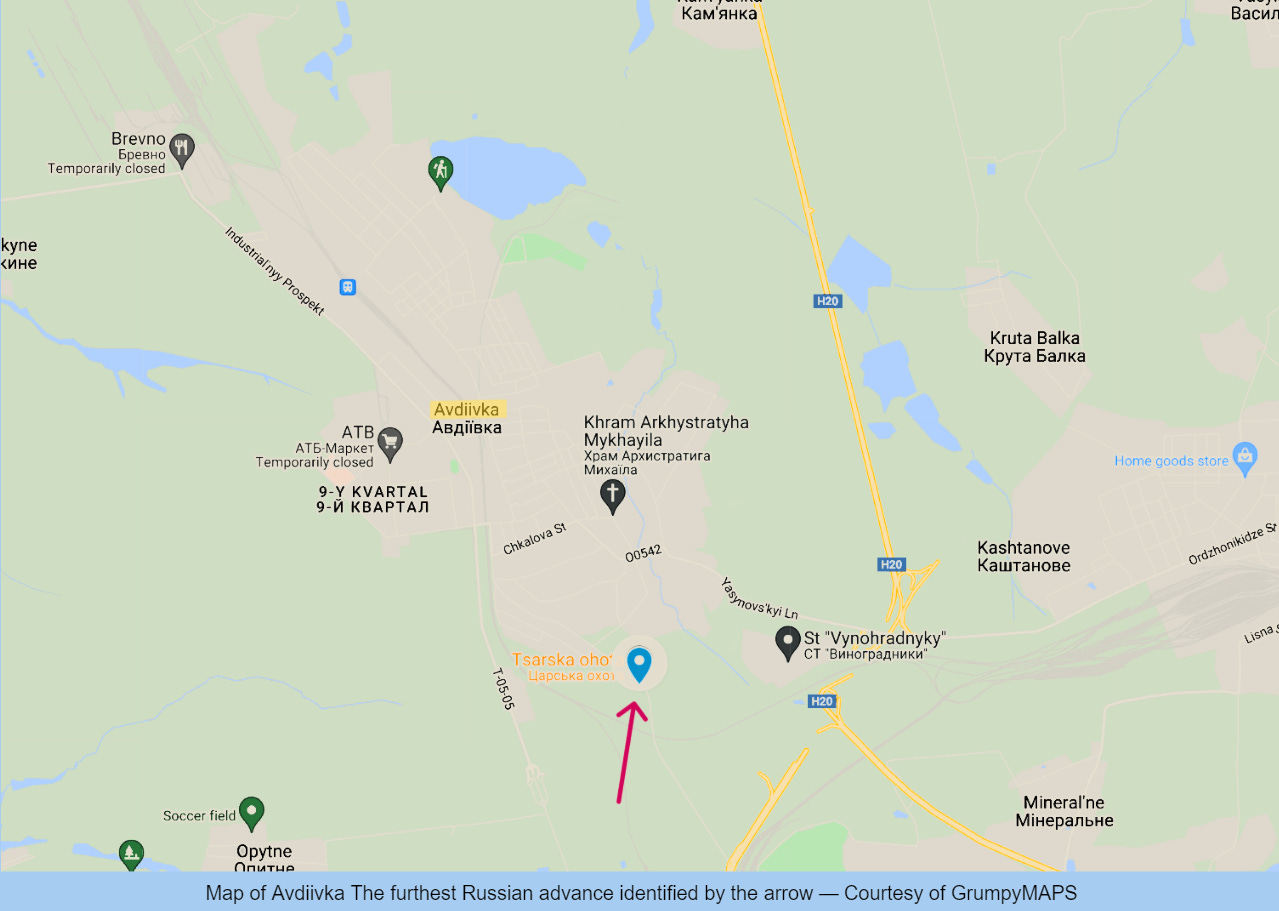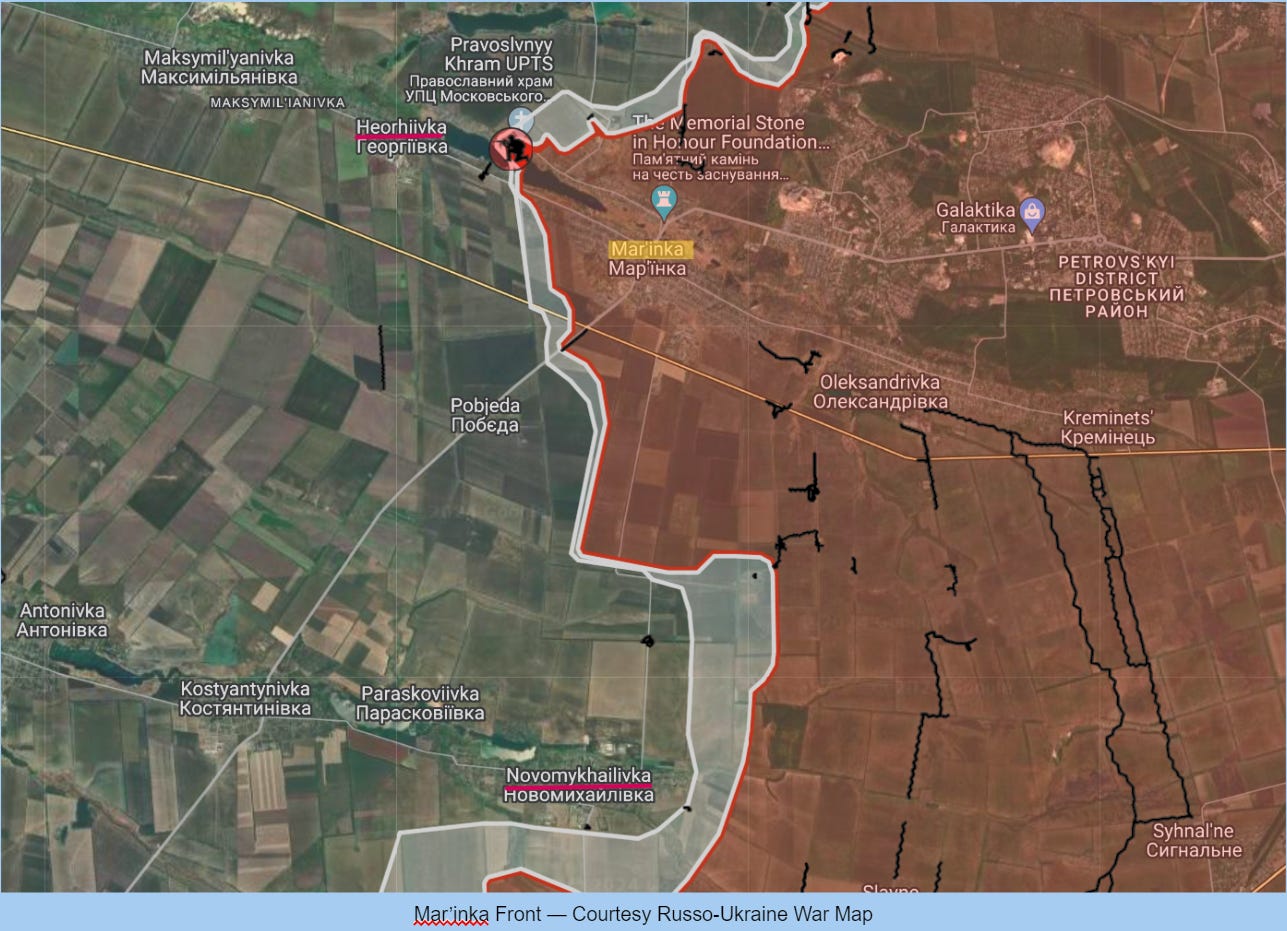Slava Ukraini! Since June 2023 I have provided a daily draft for the Ukraine War Brief Podcast collecting news from over 40 sources daily much of which ends up in the script. I will make this Draft available here for those who wish to keep up with events on a daily basis.
INSIDE UKRAINE
ALONG THE CONTACT LINE
GSAFU Morning Report
The General Staff of the Armed Forces of Ukraine in its situation update at 06:00 on Jan. 22 stated that it was day 698 of the full-scale invasion of the Russian Federation against Ukraine.
During the past day, 68 combat engagements took place. Over the past 24 hours, the enemy carried out 4 missile strikes, 102 air strikes, and 80 MLRS attacks across the positions of our troops and settlements. As a result of the Russian attacks, unfortunately, there are dead and wounded among the civilian population. Destruction and damage to residential buildings and other civilian infrastructure.
The Khortytsia operational-strategic group is responsible for the Kup’yans’k, Lyman, and Bakhmut axes, in the northeastern part of Ukraine.
Kup’yans’k axis: Ukrainian defenders repelled 7 attacks of the enemy near the settlements of Synkivka, (Kharkiv oblast).
Lyman axis: Ukrainian defenders repelled 5 attacks of the occupiers near Terny, Yampovlivka (Luhansk oblast) and attacks near Bilogorivka (Donetsk oblast).
Bakhmut axis: Ukrainian forces repelled 7 attacks near Hryhorivka, Bohdanivka, Klishchiivka and Andriivka (Donetsk oblast)
The Tavria operational-strategic group is responsible for the Avdiivka, Mar’inka, Shaktars’ke, and Zaporizhzhia axes, in the central-eastern and southeastern part of Ukraine.
Avdiivka axis: Ukrainian defenders continue to hold back the enemy who keeps trying to encircle Avdiivka. AFU soldiers are standing their ground and inflicting major losses on the invaders. Ukrainian Defense Forces repelled 5 enemy attacks near Novobakhmutivka, Stepove, Avdiivka, and 12 near Pervomais’ke and Nevel’s’ke (Donetsk oblast).
Russian Troops Reach Southern Edge of Avdiivka
The Institute for the Study of War in their Jan. 21 Russian Offensive Campaign Assessment said geolocated footage had shown Russian troops reaching the southern edge of the Donetsk region city, one of the most contested areas of the war.
According to the Institute for the Study of War (ISW), Russian forces have made “confirmed advances” in the Tsarska Okhota restaurant area along Soborna Street, which is approximately 550m southeast of the houses lying in the outskirts.
Oleksandr Tarnavskyi, commander of Ukraine’s Tavria Group of Forces, said Ukraine eliminated 399 Russian troops and 97 units of military equipment on Jan. 21 in a Telegram update, including a 240mm 2C4 self-propelled mortar.
Oleksandr Shtupun, the spokesperson of Tavria, said more than 40,000 Russian troops are concentrated in the area around Avdiivka, and the group was expecting renewed Russian assaults.
Mar’inka axis: Ukrainian Defense Forces continue to hold back the occupiers in the vicinities of Heorhiivka and Novomykhailivka (Donetsk oblast). Troops repelled 5 attacks in that area
Shakhtarske axis: The enemy did not conduct any offensive (assault) operations.
Zaporizhzhia axis: Ukrainian Defense Forces repelled 7 attacks neat Robotyne and west of Verbove, (Zaporizhzhia oblast).
The Odesa operational-strategic group is responsible for Kherson, Qırım, (also known as Crimea) and the Black Sea.
Kherson axis: Ukrainian defenders continue to expand the bridgehead. Despite significant losses, the enemy does not abandon its attempts to dislodge Ukrainian troops from their positions. Over the past day, the enemy carried 6 unsuccessful assaults on the positions of the Ukrainian Defense Forces.
TEMPORARILY OCCUPIED TERRITORIES
Nothing to report.
THE HOME FRONT
Russia attacks with 8 Shaheds all were shot down
The GSAFU reported that on the night of January 22, 2024, the enemy attacked 8 Shahed 136/13. All eight "martyrs" were destroyed by anti-aircraft missile units and mobile fire groups of the Air Force and other components of the Defense Forces of Ukraine within the Mykolaiv, Kherson, Dnipropetrovsk and Kirovograd oblasts.
Poland’s Prime Minister visits Kyiv
Prime Minister Donald Tusk arrived in Kyiv by train on Jan. 22. During his visit he will meet with President Zelenskyy and Prime Minister Shmyhal.
Tusk announced that Poland joined the declaration of the Group of Seven countries on security guarantees for Ukraine.
"Poland has joined the G7 declaration, which seeks to mobilise democratic countries to support Ukraine."
— Donald Tusk, Prime Minister of Poland
Ukrainian President Volodymyr Zelenskyy described the talks with Tusk as "very effective". The president noted that they also discussed Poland's financial support for arms purchases for Ukraine and joint weapons production.
Zelenskyy added all disagreements between Kyiv and Warsaw can be resolved through intergovernmental negotiations.
Ukrainian exports through the Black Sea increase
The UK Ministry of Defence in its Jan. 22 intelligence update stated that Ukrainian ports exported more agricultural products in December 2023 than at any time since Russia's invasion.
The MOD declared that figures were made possible by the reopening of Ukraine's main Black Sea ports and the creation of a unilateral maritime export channel.
They exceeded the monthly volumes achieved during the implementation of the Black Sea Grain Initiative mediated by the UN and Türkiye, which was subject to Russian inspections.
Ukraine has achieved this by largely preventing the Russian Black Sea Fleet from operating in the western part of the Black Sea, where it is threatened by Ukrainian missiles and uncrewed surface vessels.
UK intelligence highlighted the importance of the Black Sea export route both for Ukraine's export earnings "and as a symbol that both sides are willing to suspend attacks on civilian shipping, paving the way for diminished risk and greater trade for all in the Black Sea".
Powerful DDoS attacks on Monobank are reported
Oleh Horokhovskyi, co-owner of Monobank, a Ukrainian bank, announced powerful distributed denial-of-service (DDoS) attacks on the bank on Sunday evening.
"I think Monobank is currently one of the most attacked IT targets in the country. The DDoS attacks are ongoing incessantly. An attack with a total load of 580 million service requests has just ended. It's just a complete disaster...
As I was writing this, a new wave had started... We're standing firmly!"
— Oleh Horokhovskyi, co-owner of Monobank
Monobank had previously been attacked on Dec. 12 and Jan. 20.
Ukraine plans to restore commercial air travel
Ukraine is working "intensively" with partners to restore air travel suspended for nearly two years, with the main focus on Boryspil International Airport outside the capital Kyiv, Deputy head of President’s Office, Rostyslav Shurma, said, Reuters reported.
Ukraine's airspace was abruptly closed by Russia's invasion in February 2022 due to the security risk for civil aviation and anyone visiting has to make their way by road or rail from a neighbouring country.
Kyiv sees a restoration of air travel as a goal towards victory for the economy.
"I don't want to create over-expectations ... but I can tell you we are working very intensively to recover the air connection in Ukraine," Rostyslav Shurma, deputy head of Ukraine's presidential office, said during a panel discussion in Davos.
Shurma declined to give a timeline for the possible restoration of air travel but said Ukraine had an "internal roadmap and schedule".
THE RUSSIAN WORLD
Russian Foreign Minister avoided flying over unfriendly countries on his way to New York
Paranoia runs deep in Russia. According to propaganda outlet TASS Russian Foreign Minister Sergei Lavrov's plane flew from Moscow to the United States via a northern route that avoided unfriendly countries during a flight that lasted 12 hours and 45 minutes.
Russian Foreign Ministry spokeswoman Maria Zakharova said Lavrov would visit New York from 22 to 24 January to attend a UN Security Council debate on the Middle East and a meeting on Ukraine. Several bilateral meetings are also scheduled.
There aren't many friendly countries left out there for Russia to be honest, just sayin’
Russian air defence in Leningrad Oblast was created to defend against NATO, not attacks from the south
The Institute for the Study of War in its Jan. 21 Russian Offensive Campaign Assessment stated that Ukrainian forces conducted successful drone strikes against targets in Leningrad and Tula oblasts, where repeated Ukrainian drone strikes may fix Russian short-range air defence systems defending potentially significant targets along expected flight routes.
Ukrainian media, citing unnamed sources within Ukrainian special services, reported that Ukrainian forces conducted drone strikes against the Shcheglovsky Val Plant in Tula City, Tula Oblast and the “Novateka” plant and gas terminal near the port of Ust-Luga, Leningrad Oblast on the night of January 20 to 21.
A Russian insider source claimed on January 21 that Russian air defence coverage over Leningrad Oblast is poor and indicated that Russian air defences in Leningrad Oblast are likely not arrayed to defend against strikes from the south.
Russian air defence systems in Leningrad Oblast are most likely positioned to defend against strikes from the northwest and west, as Russia has historically arrayed its air defence in the area to defend against hypothetical NATO attacks. The Russian military is currently reforming the Leningrad Military District (LMD) with the expressed intent to prepare for a potential future conventional war against NATO and may be arranging military assets in a way to posture along the border with NATO members.
Ukrainian strikes in Leningrad Oblast could force Russian forces to redeploy short-range air defence systems along expected Ukrainian drone flight routes, to protect locations of strategic importance.
ISW believes that Russian forces may not be able to cover all potential strategic targets in the oblast using short-range anti-aircraft systems like the Pantsir, at least without deploying additional units, and that continued Ukrainian strikes deep in Russia's rear areas could increase pressure on Russian air defences in general.
Bashkir unrest a possible sign of russia’s impending collapse
Defence Express writes that in the past two years, russian society has gotten used to the Special Military Operation (SMO). These three sad letters are no longer an independent trigger for protest. The protest is now generated by certain socially active segments of the population (wives, widows, and mothers of the mobilised). In addition, russian “stability” is violated by the accompanying injustice in the form of delayed demobilisation, failure to provide the mobilised with ammunition and the inclusion of the Killed in Action in the Missed in Action roster which bears proper financial losses for the families. But these factors have not yet channelled local “fires” into an all-russian “blaze.”
The mass action in Bashkortostan fundamentally differs from the previous military protest. Thousands of Baymak residents came out demanding the release of the local activist Fail Alsynov who was sentenced to four years in prison. People decided to openly and forcefully confront government officials under the political slogans “Freedom!” and “United we are strong!”.
The protest was fueled by an article of the Criminal Code under which Alsynov was convicted: “Incitement to ethnic hatred” (Part 1 of Article 282 of the Criminal Code). According to investigators, the activist spoke in the Bashkir language using statements that negatively assess residents of the Caucasus, Central Asia, and Armenians.
The choice of the indictment article shows how afraid Moscow is of the growth of separatist sentiments in the regions. This assumption is confirmed by the brutality with which the security forces suppressed the protest rally in Bashkortostan, which snapped back with nothing but snowballs.
The political shake-up in Bashkortostan threatens the Putin regime with significantly more destructive consequences than the isolated near-war protest.
Sooner or later people will come to understand that they can really fight for their truth. Bashkortostan proved this. Non-acceptance of the central government and the possibility of direct opposition to its representatives may become a common trend for various protest groups in the regions of the russian federation. In this way, a cumulative effect can be achieved, forming a global goal for russia -- changing the political regime.
NEWS WORLDWIDE
Slovak PM Claims Ukraine Is Not a Sovereign Country
Slovak Prime Minister Robert Fico on Saturday alleged neighbouring Ukraine was not a sovereign nation but was under the absolute control of the United States, in embrace of a Russian conspiracy theory.
The populist politician, who is against military aid to the war-torn country and opposes sanctions against Russia, also reiterated his opposition to Ukraine’s bid to join NATO.
“Ukraine is not an independent and sovereign country,” Fico told public broadcaster RTVS. “Ukraine is under the total influence and control of the United States.”
Slovakia is a member of both NATO and the European Union.
Fico is due to meet his Ukrainian counterpart Denys Shmyhal on Wednesday in the city of Uzhhorod, western Ukraine, on the border with Slovakia.
“I will tell him that I am against the membership of Ukraine in NATO and that I will veto it,” Fico said.
NATO to hold largest exercises since Cold War with 90,000 troops
Reuters reports NATO is launching its largest exercise since the Cold War, rehearsing how U.S. troops could reinforce European allies in countries bordering Russia and on the alliance's eastern flank if a conflict were to flare up with a "near-peer" adversary.
Some 90,000 troops are due to join the Steadfast Defender 2024 drills that will run through May, the alliance's top commander Chris Cavoli said on Thursday.
More than 50 ships from aircraft carriers to destroyers will take part, as well as more than 80 fighter jets, helicopters and drones and at least 1,100 combat vehicles including 133 tanks and 533 infantry fighting vehicles, NATO said.
Cavoli said the drills would rehearse NATO's execution of its regional plans, the first defence plans the alliance has drawn up in decades, detailing how it would respond to a Russian attack.
"Steadfast Defender 2024 will demonstrate NATO's ability to rapidly deploy forces from North America and other parts of the alliance to reinforce the defence of Europe," NATO said.
During the second part of the Steadfast Defender exercise, a special focus will be on the deployment of NATO's quick reaction force to Poland on the alliance's eastern flank.
MILITARY & TECH
Russia uses ancient P-35 missile for first time in attack on Ukraine
Defence Express reports Russia reportedly has used a rare 4-ton P-35 anti-ship missile for the first time in its war against Ukraine.
The missile, with a length of 10 meters, was initially introduced into the Soviet arsenal in 1962 and is still in use by the Russian military.
Photographs released by Defense Express showcase the massive size of the missile, clearly displaying its distinctive wings among the wreckage. The publication, relying on its sources, has verified that the missile in question is indeed the P-35
Despite its age, the P-35 remains part of Russia’s weaponry, serving as a component in the coastal missile system “Redut.” As of 2021, Russia possessed an estimated 8 launchers for this system.
The 4K44 Redut is an early Cold War era coastal defense system of Soviet origin, designed to supplement and replace the earlier S-2 Sopka (NATO: SS-C-2b Samlet) missile batteries. The system uses the P-35 missile, also utilized on Soviet naval vessels, and is known in the West by its NATO designation SS-C-1 Sepal.
That’s it for today’s Draft folks if you would like to keep up with events in Ukraine daily please consider subscribing, its free!
Feel free to share this update with your friends. Heroyam Slava!


























